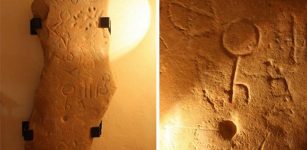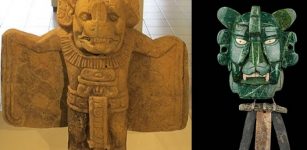Hammurabi: Great King Of Babylon And His Code Of Justice
A. Sutherland - AncientPages.com - Ancient Babylon was home to some powerful dynasties and rulers.
Hammurabi. Image credit: Windu1789 - CC BY-SA 4.0
One of them was Hammurabi, the sixth king in the Babylonian dynasty, who ruled in central Mesopotamia (modern Iraq) from 1792 to 1750 BC.
Who Was This Great King Of Babylon?
First, he proclaimed one of the earliest and most complete ancient legal codes but also contributed much more.
Hammurabi ("Hammu" means "family" in Amorite, and "rapi" means "great" in Akkadian) was one of the most significant historical figures of antiquity; he was a builder, conqueror, and lawmaker.
Ancient sources say that he built up Babylon until it was more powerful than Ur or any other city of its time and made the town the religious center.
Marduk, son of Enki, was declared Babylon's god and the greatest of all the gods, which gave him power and authority to relieve his father of his rank as chief god. Despite many protests, it happened according to Hammurabi's decision.
At the time Hammurabi ascended to the throne, Babylon was already a great state, which included, among others, Kish, Sippar, and Borsippa; however, Hammurabi recognized the authority of Shamshi-Adad I, king of Assyria and Mari, at that time. In the 30th year of his reign, he expanded his kingdom by conquering Larsa, Eshnunna, Assyria, and Mari. For the first time since the Third Dynasty of Ur, he created a powerful Babylonian Empire.
While involved in military and political advances, he also supervised his irrigation projects and the construction of fortifications and temples celebrating Babylon's patron deity, Marduk. Building spectacular pyramids, temples, and towers was difficult because there was no stone in Babylonia.
The Statue of Marduk depicted on a cylinder seal of the 9th century BC Babylonian king Marduk-zakir-shumi I. Detailed info, from Schaudig (2008). Image credit: Franz Heinrich Weißbach - Public Domain
According to Hammurabi's ingenious designs, the impressive structures of Babylon were built of bricks by molding and baking the clay, which hardened into bricks with perfect quality that has survived until today.
At its peak, Babylon, a trade and cultural center, was inhabited by about 200,000 people; at the center of this gigantic city with towers, palaces, and gardens, there was a vast ziggurat, estimated to be about 300 feet tall, according to archaeologists.
The splendid reign of Hammurabi lasted fifty−five years. After his death, great Babylon gradually declined.
The extent of the Babylonian Empire at the start and end of Hammurabi's reign, located in what today is modern-day Kuwait and Iraq. Image credit: MapMaster - CC BY-SA 4.0
Not much is left after Hammurabi's spectacular Babylon; no archives survived, and the only reliable historical documents that tell stories about Babylon are clay tablets unearthed at other locations.
Code Of Hammurabi
One of Hammurabi's most famous achievements is his law code (influenced mainly by Sumerian culture), which included many harsh punishments.
His Code, discovered in 1901, proclaimed at the end of Hammurabi's reign and supporting the doctrine of 'an eye for an eye' – is a collection of 282 laws and standards, indispensable rules for commercial interactions and punishments to meet the requirements of justice.
The black stone stele containing Hammurabi's Code was made from a single, four-ton slab of diorite, a durable but difficult to carve.
At its top is a two-and-a-half-foot relief carving of a standing Hammurabi receiving the law— symbolized by a measuring rod and tape—from the seated Shamash, the Babylonian god of justice.
Hammurabi’s Code. The prologue of the Code of Hammurabi (the 305 first inscribed squares on the stele). Some gaps in the list of benefits bestowed on cities recently annexed by Hammurabi may prove the tablet is older than the celebrated basalt stele (also in the Louvre). Image credit: Unknown artist - Louvre Museum
The rest of the seven-foot-five-inch monument is covered with columns of chiseled cuneiform script.
Hammurabi's Code was looted by later invaders and rediscovered in 1901 by a French archaeological team in present-day Iran.
The Code's 282 edicts – from family law to professional contracts and administrative law – are all written in 'if-then form. The edicts outline different standards of justice for the three classes of Babylonian society – the propertied class, freedmen, and enslaved people. A doctor's fee for curing a severe wound would be ten silver shekels for a gentleman, 5 shekels for a freedman, and two for an enslaved person.
Penalties for malpractice followed the same scheme: a doctor who killed a wealthy patient would have his hands cut off, while only financial restitution was required if the victim was enslaved.
Hammurabi's Code was not the earliest collection of laws, but his version became the most complete and famous in human history.![]()
Written by – A. Sutherland AncientPages.com Staff Writer
Updated on March 24, 2024
Copyright © AncientPages.com All rights reserved. This material may not be published, broadcast, rewritten or redistributed in whole or part without the express written permission of AncientPages.com
Expand for referencesReferences:
Goodspeed, G. S. A History of the Babylonians and Assyrians
Kriwaczek, P. Babylon: Mesopotamia and the Birth of Civilization
Charles River Editors. Babylon
More From Ancient Pages
-
 Unique Medieval Horsemen Sculptures Made By Unknown Creators In India – Puzzling Discovery In The Himalayas
Archaeology | Oct 23, 2017
Unique Medieval Horsemen Sculptures Made By Unknown Creators In India – Puzzling Discovery In The Himalayas
Archaeology | Oct 23, 2017 -
 Neolithic People Ate Focaccia As Far Back As 9,000 Years Ago
Human Beginnings | Nov 25, 2024
Neolithic People Ate Focaccia As Far Back As 9,000 Years Ago
Human Beginnings | Nov 25, 2024 -
 On This Day In History: Stone Of Destiny Stolen From Westminster Abbey In London – On Dec 25, 1950
News | Dec 25, 2016
On This Day In History: Stone Of Destiny Stolen From Westminster Abbey In London – On Dec 25, 1950
News | Dec 25, 2016 -
 Mysterious Undeciphered Carvings And Script On Stela Of Montoro
Archaeology | Aug 14, 2017
Mysterious Undeciphered Carvings And Script On Stela Of Montoro
Archaeology | Aug 14, 2017 -
 Native American Population Does Not Originate In Japan – Genetics And Skeletal Biology Questioned
Archaeology | Nov 15, 2021
Native American Population Does Not Originate In Japan – Genetics And Skeletal Biology Questioned
Archaeology | Nov 15, 2021 -
 Pax Romana: 200-Year-Long Period Of Stability Within The Roman Empire
Ancient History Facts | Apr 19, 2016
Pax Romana: 200-Year-Long Period Of Stability Within The Roman Empire
Ancient History Facts | Apr 19, 2016 -
 Copiale Cipher – Secrets Of Mysterious Coded Manuscript And The Oculist Order
Artifacts | Feb 4, 2019
Copiale Cipher – Secrets Of Mysterious Coded Manuscript And The Oculist Order
Artifacts | Feb 4, 2019 -
 Discovery Of 1500-Year-Old Celestial Observatory Dated To Sassanian Empire
Archaeology | Mar 16, 2017
Discovery Of 1500-Year-Old Celestial Observatory Dated To Sassanian Empire
Archaeology | Mar 16, 2017 -
 Mystery Of Giant Gogmagog’s Hidden Treasure Beneath Castell Dinas Bran
Featured Stories | Jan 23, 2025
Mystery Of Giant Gogmagog’s Hidden Treasure Beneath Castell Dinas Bran
Featured Stories | Jan 23, 2025 -
 Unique Archaeological Finds Point To The Lost Indigenous Town Of Sarabay In Florida
Archaeology | Jun 20, 2022
Unique Archaeological Finds Point To The Lost Indigenous Town Of Sarabay In Florida
Archaeology | Jun 20, 2022 -
 Amaru (Katari) – Powerful Inca God Who Controlled Weather Phenomena
Featured Stories | Apr 9, 2024
Amaru (Katari) – Powerful Inca God Who Controlled Weather Phenomena
Featured Stories | Apr 9, 2024 -
 America’s Oldest City Caral Illegally Invaded And Archaeologist Threatened With Death
Archaeology | Jan 21, 2021
America’s Oldest City Caral Illegally Invaded And Archaeologist Threatened With Death
Archaeology | Jan 21, 2021 -
 1,200-Year-Old Human Skeleton With A Jade Ring Unearthed In El Tigre Archaeological Zone
Archaeology | Aug 15, 2023
1,200-Year-Old Human Skeleton With A Jade Ring Unearthed In El Tigre Archaeological Zone
Archaeology | Aug 15, 2023 -
 Vast Fortification Enclosing Walled Oasis Dating Back 4,000 years In North-Western Arabia – Unearthed
Archaeology | Jan 10, 2024
Vast Fortification Enclosing Walled Oasis Dating Back 4,000 years In North-Western Arabia – Unearthed
Archaeology | Jan 10, 2024 -
 Who Were The Ancient Maya Bat People?
Featured Stories | Jul 13, 2021
Who Were The Ancient Maya Bat People?
Featured Stories | Jul 13, 2021 -
 Siege Of Alesia: Last Decisive Battle That Ended Gallic Independence In France And Belgium
Featured Stories | Feb 1, 2017
Siege Of Alesia: Last Decisive Battle That Ended Gallic Independence In France And Belgium
Featured Stories | Feb 1, 2017 -
 Rare ‘Polishing Boulder’ Used By Stone Age People Found In Dorset, UK
Archaeology | Aug 26, 2023
Rare ‘Polishing Boulder’ Used By Stone Age People Found In Dorset, UK
Archaeology | Aug 26, 2023 -
 Archaeologists Investigate A Fascinating Ice Age Mystery In A Cave Beneath A British Castle
Featured Stories | Oct 9, 2024
Archaeologists Investigate A Fascinating Ice Age Mystery In A Cave Beneath A British Castle
Featured Stories | Oct 9, 2024 -
 Central Asia Identified As A Key Region For Human Ancestors
Archaeology | Oct 22, 2022
Central Asia Identified As A Key Region For Human Ancestors
Archaeology | Oct 22, 2022 -
 Dunino Den: Mysterious And Sacred Ancient Site In Scotland With Enigmatic Rock Faces And Symbols
Featured Stories | Jan 6, 2017
Dunino Den: Mysterious And Sacred Ancient Site In Scotland With Enigmatic Rock Faces And Symbols
Featured Stories | Jan 6, 2017




